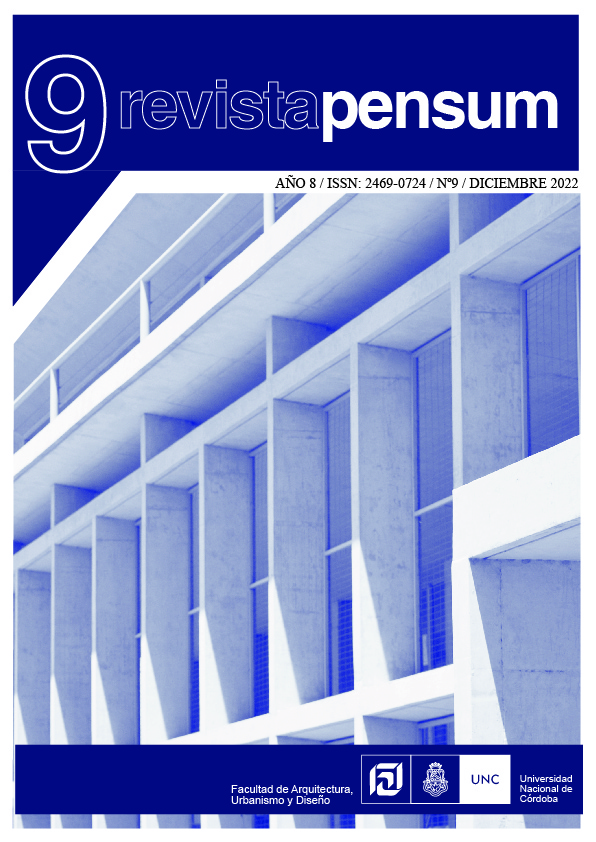Water to urbanize, railway to communicate
A review of the infrastructures of the 19th century in Córdoba-Argentina
DOI:
https://doi.org/10.59047/2469.0724.v8.n9.39433Keywords:
Water infrastructures, railway, metropolitan territory, CórdobaAbstract
The present work deals with the study of the infrastructures linked to water and the railway, developed in the city of Córdoba and its metropolitan territory in the period 1880-1914. For this article, a review of two antecedents that were key in the process of formation of this territory is proposed. The completion of the irrigation project “Los Altos de Córdoba” (1881-1891) and the development of the “Tren de las Sierras” railway system, built by the Ferrocarril Córdoba y Noroeste (Córdoba & Western Railway Co. Ltd.) from of 1886. These cases meant a progressive advance in land use planning, defining infrastructures as central devices for its transformation. The condition of implantation of the city and its region, the political ideology of progress and modernization led by the generation of '80 and the search to insert this territory in the national context, had a central participation in the physical development of the territory as demonstrated in continuation.
References
Ansaldi, W. (1997). Una Modernización Provinciana: Córdoba, 1880-1914. Estudios, (7-8). https://revistas.unc.edu.ar/index.php/restudios/article/view/13950
Boixados, M. C. (2000). Las tramas de una ciudad, Córdoba entre 1870 y 1895. Élite urbanizadora, infraestructura, poblamiento. Ferreyra Editor.
Bustamante, J. (2014). “La construcción de un paisaje cultural a escala del territorio: el camino de las usinas del río Suquía Córdoba, Argentina”. En Revista Labor & Engenho.
Camarasa, J. (2012). Historias secretas de Córdoba. Alfaguar.
Choay, Françoise. (2003) O Urbanismo. Utopias e Realidades. Uma Antologia (1965). São Paulo: Editora Perspectiva, 2003
Cohen, D, Peralta, J, Romanutti, A. “Procesos de modernización y transformación del paisaje agrícola en el Área Metropolitana de la ciudad de Córdoba Argentina: el Caso de Colonia Caroya”. Revista Labor & Engenho, ISSN: 2176-8846.
Dumesnil, E, Casaffousth, C. (1884) Irrigación los altos de la ciudad de Córdoba. Memoria presentada al exmo. Gobierno de la provincia. Imprenta de “El interior.”.
Frías, L.R. (1986). Historia del Dique San Roque. Córdoba, Argentina: Municipalidad de Córdoba. Talleres Gráficos de la Dirección de Documentación e Imprenta de la Municipalidad de Córdoba
Giobellina, B. (2017). El cinturón verde de Córdoba: hacia un plan integral para la preservación, recuperación y defensa del área periurbana de producción de alimentos. Ediciones INTA.
Harvey, D. (2000). “Mundos Urbanos posibles”. En Lo urbano en 20 autores contemporáneos (Ramos Ángel Martin, p. 219). España, Barcelona: Universidad Politécnica de Cataluña. Recuperado de https://bibliodarq.files.wordpress.com/2014/09/ramos-a-m-lo-urbano-en-20-autores-contemporc3a1neos.pdf
Huergo, L. (1888). Obras de riego los Altos de Córdoba. Laudo Arbitral. Dictamen pericial. Imprenta de Martín Biedma, Buenos Aires.
Iros, G., Moiso, E., Alonso, C. y Bravo, A. (5-7 de setiembre de 2018) Plan Director para la región de Sierras Chicas, Córdoba, Argentina. XII Congreso Internacional Ciudad y Territorio Virtual: “Ciudades y Territorios Inteligentes”, Mendoza, Argentina.
Lopez, A. L. (2008). ¿Las infraestructuras como proyecto de ciudad? Algunas reflexiones sobre burgos, ciudad intermedia de Castilla y León.” CIUDADES 11. Recuperado de file:///C:/Users/usuario/Downloads/LAS_INFRAESTRUCTURAS_COMO_PROYECTO_DE_C.pdf
Martínez, M. (2015). Los pueblos del desierto. El proceso de ocupación y urbanización del Territorio Nacional de La Pampa, Argentina. [Tesis de Doctorado, Universidad Politécnica de Cataluña]. Recuperado de https://upcommons.upc.edu/discover?scope=%2F&query=LOS+PUEBLOS+DEL+DESIERTO&submit. Montiel Alvarez, T. (2014). Ciudades hacinadas y las "Company Towns". ArtyHum, Revista digital de Artes y Humanidades, 7, 159-169.
Orgaz, R. (1950). Sociología Argentina. (Tomo 2), Assandri.
Pírez, P. (2013). “La urbanización y la política de los servicios urbanos en América Latina.” ANDAMIOS, Volumen 10, número 22, 45-67.
Rabboni, N. Abdale, I. (2019). “El desarrollo territorial del Valle de Punilla: el turismo como motor de despegue (1880 - 1905)” XXI Jornadas de Geografía de la UNLP.
Rigotti, A. M. (2014). Las invenciones del urbanismo en Argentina 1900-1960: inestabilidad de sus representaciones científicas y dificultades para su profesionalización. - 1a ed. - Rosario: UNR Editora. Editorial de la Universidad Nacional de Rosario. Facultad de Arquitectura, Pleneamiento y Diseño; A&P, E-Book. - (Tesis doctorales) ISBN 978-987-702-088.
Sabaté Bel, J. (2011). “Paisajes culturales. El patrimonio como recurso básico para un nuevo modelo de desarrollo.” Urban, (9), 8-29.http://polired.upm.es/index.php/urban/article/view/380
Terzaga, A. (1963) Geografía de Córdoba. Reseña física y humana. Assandri.
Testani, M, C. (2004) El tren de las Sierras de Córdoba: Una recopilación de historias y anécdotas. M. Ceferino Testani.
Torres Flores, M. L. (2010). El abastecimiento de agua corriente en la ciudad de Córdoba (1900-1910): continuidad y cambio en la gestión Res Gesta, (48) https://repositorio.uca.edu.ar/handle/123456789/5789
Downloads
Published
Issue
Section
License
Copyright (c) 2022 Julia Schiavoni

This work is licensed under a Creative Commons Attribution-ShareAlike 4.0 International License.
Authors who publish in this journal agree to the following terms:
a. Authors retain copyright and guarantee to the journal the right to be the first publication of the work as well as licensed under a Creative Commons Attribution-ShareAlike 4 license.
b. Authors may separately establish additional agreements for non-exclusive distribution of the version of the work published in the journal (e.g., placing it in an institutional repository or publishing it in a book), with an acknowledgement of its initial publication in this journal.
c. Authors are permitted and encouraged to disseminate their work electronically (e.g., in institutional repositories or on their own website) before and during the submission process, as this may result in productive exchanges, as well as earlier and greater citation of published work (See The Effect of Open Access).
d. 4.0 International Creative Commons Attribution-ShareAlike 4.0 License.












